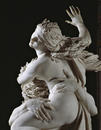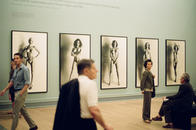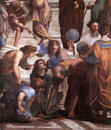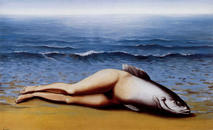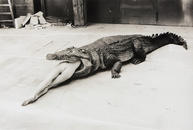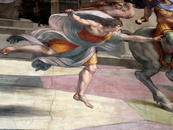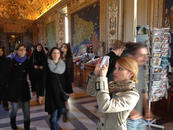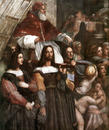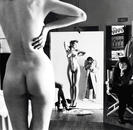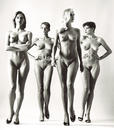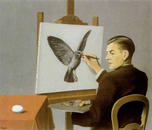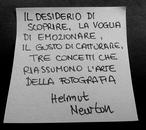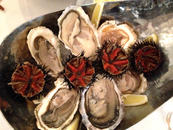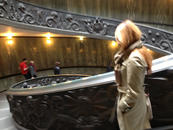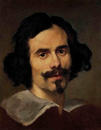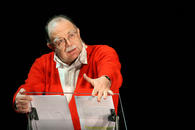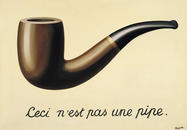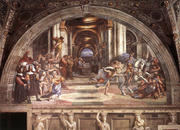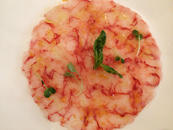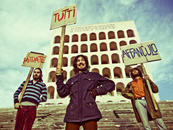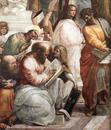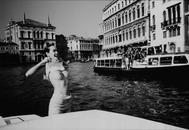Art, desire for the living form
My umpteenth visit to the Vatican Museums and the Galleria Borghese, as well as the Roman exhibition of Helmut Newton, have caused me to reflect again on the problem of the fruition of a work of art and the relationship of this with reality. Infinitesimal details made me perceive a thick and somewhat sticky contradiction.
Some parts (hands, feet, shoes, but also some faces and bodies) were literally and surprisingly "removed" by Raphael and his entourage, in the Stanze Vaticane, which, among other things, were recently cleaned and very well restored. And then there were the shoe prints left on the platform of the photo studio in the images of the Big nudes by Helmut Newton. The meat of the thighs of Persephone who yields to the iron grip of Pluto in the great marble sculpture by Bernini stored at Villa Borghese.
These are just three of the many details that undermined a serene vision of the art. A serene vision that, by the way, I do not look for when viewing art. Blessed details that are necessary because with about the revelatory detail reality is not perceived, it isn’t magnetized, it doesn’t give us the chills. To paraphrase Walter Siti, art, great art, is in fact the anti-habit, the unexpected detail that opens a tear in our mental stereotype, which finally seems to leave us a glimpse of the thing in itself, the infinite reality; art is a form of falling in love...
Let me try to explain. Due to errors and approximations present in the Stanze Vaticane I could focus on the artists, I could feel the fatigue of those painters, their fickle and capricious talent on the scaffold, led by a capable and charismatic genius; but not omniscient. I could feel and almost see the famous man, proud of his art, turn a blind eye to the errors and approximations; because an artist able to finish and refinish hundreds of details certainly is able to see and fully evaluate these approximations and errors, that my mediocre and inexperienced eye found not hard to grasp. So I "heard" Raphael mulling over whether or not to revise that given detail or even if it was not the case to scrape it off and redo that part of the fresco. Raphael’s doubt, which I imagined vividly, made the work of art come to life before my very eyes. It ceased to be an icon, a fetish. I was able to look at it well, really appreciating the works in the rooms, which in the end is almost everything and in the highest degree, from the design of the figures to the rhythm of the composition, from the use of light to the painting technique. Having noticed the little details (the unexpected detail that opens a tear in our mental stereotype) emphasized, enhanced rather, what was intended to make perfection. A path of humanization of the work. It’s like the error reveal the subject of that divinity - the perfect painting of the famous painter – according to the laws of life.
I experienced something similar, but very different in size and depth, a little later in the halls of the Palazzo delle Esposizioni, where some of Helmut Newton’s most famous photos were on display, the series White women, Sleepless nights, Big nudes. I will omit a detailed analysis of his work here to dwell only on the Big nudes, seen for the first time in their original format, after having admired countless times in smaller versions in magazines and books, the first time in memorable issue of the Illuztrazione Italiana from April 1982. The evident grain, the lack of digital photo editing (Photoshop didn’t exist), but above all, as mentioned, the dirty floor with the shoe prints from the models. The dirt was not ostentatious, just stated, so natural ... how many times have I deleted a detail like that when editing fashion photos! It is as if the giant beauties were there in front of me, alive, beautifully nude. And they were there solely because of that detail, that mistake (the unexpected detail that opens a tear in our mental stereotype) which made the photos real; photos that otherwise, as is often the case with Newton, would have been cloying and forced reproductions of mannequins filled with artificial pomposity, the total lack of expressiveness, empathy and humanity.
And what to say about the meat of marble that gives softness and warmth when touched by the great hand of Pluto? What to say about the white metamorphic rock that thanks to the skill of an artist of genius ceases to be cold and inert matter? Every time I imagine the grin of satisfaction of Bernini upon finishing and polishing that detail, in that triumph formally recognized by an ability that is almost sneer, as is shown in an exaggerated way in the sculpture Apollo and Daphne. And here, in Bernini's marble, in contrast to the two previous experiences and in a somewhat paradoxical way, it seems that from his almost inhuman skill emerges the humanity of the craftsman. I feel him alive beside me, full of himself (and rightly so, for that matter).
Bernini himself claimed that the goal of art is to make sure that everything is fake but looks real. In this game of reality and fiction, which is also a subtle play of persuasion and rhetoric, outlines the approach to most artistic expression (almost all, except the rare works of Dichter, the best poets, who can dig deep and open worlds). The already mentioned Walter Siti who in his recent essay on realism in art states that the ultimate goal, the goal of the magic, is the much-maligned identification. As long as the viewer of art identifies himself with what he is being told, he does not see himself as being the victim of a hoax.
What happened in the three examples above? I identified with the works in three different ways, but in all three cases it occurred after a moment of wonder. This identification creates dialogue between the viewer and the work, but the main reaction is wonder. Without a moment of wonder, which is above all a gesture of humility, it is very unlikely to trigger the identification. But it is equally certain that if we stop only wonder, we dig a furrow, creating a barrier between us is the work.
Carlo Ossola gives us a nice interpretation: "Tension animates the artistic representation, construction of signs but also the desire for the form living", which perfectly sums up everything I wanted to illustrate above.
If you reread what I wrote, however, a problem emerges; it seems to me that something is missing, and that something concerns its meaning. Faced with this kind of work I feel wonder, identification, I identify details that work (but what does work mean?), and I feel desire. In the best cases, I also feel abandonment.
If someone asked me: but what does this art mean? What do the illustrations of the Stanze Vaticane mean, and the big photos of Newton and the wonderful rear of Persephone?
But in this way, in search of meaning, I should analyze spurious commissions, and then excuses petty, personal pride, craving success and money ... After all, the pope served his favorite artist for his earthly purposes of omnipotence in a society where faith and absolute dominant force held an ambiguous role, while Helmut Newton, four centuries later, was able to emerge from the muck a society where sexual desire, glossy images, entertainment, money and goods were all, had in the meantime been replaced faith and the absolute ...
In search for meaning, I feel the hopelessly contamination of wonder and empathy. And dismount of all desire, it goes without saying. Wonder, empathy, desire, abandonment: synonyms and part of the beauty ...
"If one looks at a thing with the intention of trying to discover what it means, one ends up no longer seeing the thing itself, but thinking of the question that has been raised”. Magritte is talking, and I think that with these few words, referring to the artistic object, has explained it all They are confirmation that art is a form of falling in love (of beauty).
With love, we all believe, more or less, that it is necessary to experience wonder at the beginning, then identification and desire and finally abandonment. With love, we all believe, more or less, that it is necessary to try to find a logical explanation for falling in love is only the beginning of utter incomprehension. And if you don’t believe so perhaps we had better believe it.
09/04/2013 Filippo Maglione

